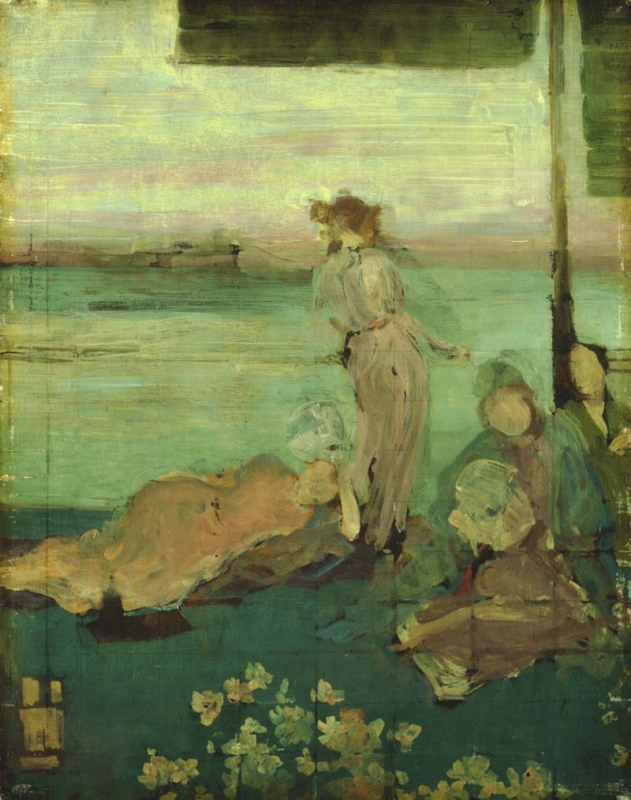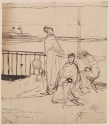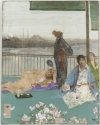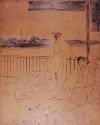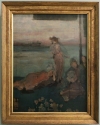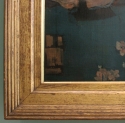Home > Catalogue > Browse > Sketch for 'The Balcony' << >>
Composition
The date and purpose of this oil sketch are difficult to establish, and the sequence of the development of the composition, from pencil, pen, and watercolour sketches, to this oil sketch, to the finished and exhibited painting, and possibly to an enlarged version of the same composition, is not at all clear.
There are two drawings for, or studies related to, the 'Balcony' composition. Sketch for 'Variations in Flesh Colour and Green: The Balcony' [M.0319], in pen and ink (reproduced above), appears to be the earliest idea and has a different figure at right, a woman seated on a stool and bending forward.
The other is a watercolour, Study for 'Variations in Flesh Colour and Green: The Balcony' [M.0320], which was actually traced from the more finished oil, Variations in Flesh Colour and Green: The Balcony. It has flowers in the foreground that appear to be an addition (they are painted in body-colour), and there is no cartouche. The watercolour appears to represent an intermediate stage, possibly in preparing Variations in Flesh Colour and Green: The Balcony for the Royal Academy in 1870.
Sketch for 'The Balcony' and Variations in Flesh Colour and Green: The Balcony [YMSM 056] are very similar indeed in composition and size. Some of the pink- and peach-coloured draperies in the 'Sketch' were painted over what appear to be figures identical in form and colour to those worn by the models in Variations in Flesh Colour and Green: The Balcony. This suggests that the 'Sketch' is a slightly later stage in the development of the composition, or that, having originally been almost identical to Variations in Flesh Colour and Green: The Balcony, the 'Sketch' was materially altered with the aim of developing an alternative scheme.
The 'Sketch' incorporates the foreground flowers and a cartouche (for a signature) in the lower left-hand corner. These flowers and a butterfly monogram were added to Variations in Flesh Colour and Green: The Balcony, possibly in or very shortly after 1870, but other details are different.
The right arm of the standing figure, which is straight in Variations in Flesh Colour and Green: The Balcony, curves along the side of her body, and the whole figure has a strong backward curve. In addition, her dress, dark greenish–blue in Variations in Flesh Colour and Green: The Balcony, is a pale pink. The fan of the figure lying down, blue in Variations in Flesh Colour and Green: The Balcony, is pink in the 'Sketch', and the blue/grey robe on which she is lying extends over her shoulder in the 'Sketch'. In the 'Sketch', the girl playing a lute (shamisen) is wearing a dress or robe of a purplish shade, and a large light-coloured object, possibly a fan, is painted on her right side; in 'The Balcony' she wears much brighter and more decorative robes, but it is possible that a similar light-coloured robe is underneath the purplish dress seen in the 'Sketch'.
Technique
Sketch for 'The Balcony' is painted on a 21mm thick mahogany panel, constructed from a single section of timber. 1 It was sized with animal glue and then primed on both sides with a commercial priming of lead white, some chalk and traces of barium sulphate, in oil. Whistler applied a substantial dark grey imprimatura made from lead white and bone black in oil to the front. 2 The upright post appears to have been painted with brown imprimatura. The whole composition is painted over a dark background, against which the light colours stand out strongly. Blue paint underlies most of the composition – thus the sky, painted with horizontal brushstrokes, overlies blue – except where the architectural elements were done first in brown. The brushstrokes that depict the sky and water strokes are painted right up to these features and also to the head of the standing woman.
A medium or ‘sauce’, which might include copal as well as a natural resin such as mastic, was added to the paint. The pigments used include combinations of vermilion, madder, another red lake, pale and mid-chrome yellow, Prussian blue, and synthetic ultramarine; there is also some chrome orange and Indian red. For example, the peach-coloured robe contains vermilion, chrome orange, and a red earth pigment (Venetian or Indian red). The olive green of the screen includes lead white, chrome yellow, Prussian blue, vermilion, and ivory black. There is Prussian blue in the water and sky, mixed with raw umber and black – possibly ivory black – for the distant water, and with chrome yellow near the balcony. Bone black and umber were used for darkening and perhaps also as a universal harmoniser, in several mixtures. The paint goes neatly to the edges but does not run over the sides, except for slight staining where it has been wiped. Brushes 1cm wide were used on the sky, a smaller brush for the figures. 3
The figures were painted first, and the standing figure initially had a red sash (with paint containing vermilion) which was modified to a purplish pink. The pose of models was altered by wiping off partly dried paint, and painting straight over it, with further wet-on-wet working and wiping until the poses were finalised. There are signs of alterations: the figure lying down was originally 7 mm higher and her fan was higher up and to the right, and the seated figure with a shamisen was both higher and to the right, with her blue robes extending further left.
The reclining figure in her peach-coloured robe is surrounded by a complementary band of blue–green. The paint dried fast and must have been thinned with a fast-drying solvent, not oil. Faces were added at a late stage. The foreground flowers were added last, over wet and drying paint, with some of the same paint mixture used for the faces.
Sketch for 'The Balcony' is roughly 'squared' (in fact the ruled lines create rectangles) for transferring the composition to another or a larger canvas or panel. There are pin holes at intervals down each side of the panel, from which thread or thin wire would have been laid over the painting. The pin holes may have been meant to be regular but the spaces between them vary by up to 5 mm. 4 This irregularity would have made it very difficult to transfer the composition accurately to another support. Some of the paint covers, or partially covers, these ruled lines; in fact it looks as if the thread was laid over some parts while it was still wet.
There is no documentary record of Whistler transferring the composition to another canvas.
However, the 'squaring' does suggest that the artist had intended to use the lines to help in the transfer of an earlier drawing to the wood panel of Sketch for 'The Balcony', or, alternatively, the 'squaring' could be for enlarging the composition of Sketch for 'The Balcony' onto a larger canvas, as Whistler in 1867 told Fantin-Latour he planned to do for the Salon. 5 Furthermore, the alterations made to Sketch for 'The Balcony' may indicate that Whistler planned to change the composition of Variations in Flesh Colour and Green: The Balcony, before enlarging it.
Conservation History
It is in good condition despite some paint loss at the edges and below the standing figure, and subsequent retouching. 6
Frame
70.2 x 59.4 x 5.4 cm.
Notes:
1: Mahogany support, tangential cut, painted on reverse and not in the least warped or cracked, neat edges. Report by Professor Joyce H. Townsend, Tate Britain, June 2016, GUL WPP.
2: Condition report by Clare Meredith, 8 May 2001, Hunterian files; Report by Professor Joyce H. Townsend, Tate Britain, 2017, GUL WPP.
3: Technical analysis carried out at the Natural History Museum EM Unit, London; reports by Professor Townsend, 1993 and 2017.
4: The holes are on the sides of the panel, and reading from left to right along the bottom edge, the distances hole to hole measure 59 mm, 63 mm, 61 mm, 58 mm, 60 mm, 60 mm, 61 mm, and 60 mm to the right edge of the panel; along the top, left to right, they measures 58 mm, 62 mm, 60 mm, 59 mm, 58 mm, 58 mm, 63 mm, and 62 mm to the end; along the left edge, reading from top to bottom, the distance between holes is 39 mm, 37 mm, 38 mm, 38 mm, 39 mm, 37 mm, 39 mm, 37 mm, 37 mm, 39 mm, 37 mm, 37 mm, 38 mm, 37 mm, 37 mm, and 39 mm to the end; along the right edge, reading from top to bottom, the distances between holes are 38 mm, 37 mm, 38 mm, 38 mm, 39 mm, 37 mm 38 mm, 38 mm, 38 mm, 39 mm, 37 mm, 37 mm, 38 mm, 38 mm, 37 mm, and 39 mm. Measured by Professors J. H. Townsend, Tate Britain, and Christina Young, University of Glasgow, 2017.
5: [June/July 1867], GUW #08045.
6: Meredith, 8 May 2001, op. cit.
Last updated: 28th December 2020 by Margaret

